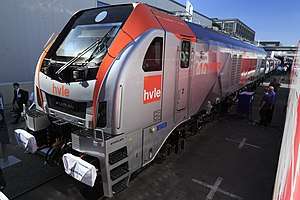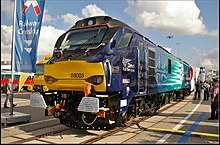Stadler Euro Dual
The Stadler Euro Dual (known as the Vossloh Euro Dual until 2015) is a series of dual power, electro-diesel locomotive by Stadler Rail Valencia. Unlike traditional dual mode locomotives, fitted with relatively low-powered diesel engines for 'last mile' movements only, vehicles are typically furnished with power units more comparable to that of mainline diesel locomotives.
| Stadler Euro Dual | |||||||||||||||||||||||||||||
|---|---|---|---|---|---|---|---|---|---|---|---|---|---|---|---|---|---|---|---|---|---|---|---|---|---|---|---|---|---|
 Stadler Eurodual II at InnoTrans fair 2018 | |||||||||||||||||||||||||||||
| |||||||||||||||||||||||||||||
| |||||||||||||||||||||||||||||
| |||||||||||||||||||||||||||||
| Sources = Standard design[1] * UK locomotives[2] † Prasa locomotives[3] | |||||||||||||||||||||||||||||
The Euro Dual series was launched by Vossloh during 2012, it shares a considerably large portion of its design with the single power Euro Light family of locomotives. Being customisable to meet customer demands, various sized powerplants can be fitted to the type; it can also be configured as a tri mode vehicle via the installation of a battery pack. To date, there are three distinct versions of the Euro Dual that have seen customer use; the UKDual for the United Kingdom, the PrasaDual for South Africa and an unbranded series for Germany. By late 2019, a total of 30 locomotives had been constructed, while a total of 74 Euro Duals were reportedly on the company's books.[4]
Background
At Innotrans 2012, Vossloh announced the launch of its range of dual mode locomotives; the company's initial offerings included the DM30 based on the Vossloh DE 18, and the EuroDual locomotives derived from its diesel Euro 4000 and EuroLight classes. Specifically, the Euro Dual shares the majority of its design, including elements such as the bodyshell, braking systems, bogies, traction equipment and software, with the Eurolight series.[5][6] Initial descriptions issued by Vossloh were of a Co'Co' locomotive with 5 MW electrical power and 0.7 to 2.8 MW (940 to 3,750 hp) diesel power, with an axle load from 17 to 22.5 t (16.7 to 22.1 long tons; 18.7 to 24.8 short tons).[3] Subsequent orders differed from the initial specifications, with orders from the UK and South Africa being for Bo-Bo locomotives.[2] At Innotrans 2018, the new Eurodual was presented by Stadler; the first two versions are marketed as UKDual and PrasaDual, while a third variant of the EuroDual featured the Co-Co wheel arrangement.[7]
In comparison to historic dual mode locomotives, the Euro Dual series was not designed with a low-powered diesel powerplant intended only for 'last mile' operations with restrictive acceleration, speed, and range; rather, it was a full capable locomotive in either diesel or electric modes.[4] It has been designed for routinely handling heavy freight consists, the series is reportedly expected to function as a dual-mode replacement for the successful Euro 4000, which will soon cease production as the latter is not compliant with European Stage IIIA emission standards. The Euro Dual is suitable for both passenger and freight applications, being able to operate at speeds of up to 160 km/h.[8] The market for dual mode trains is seen to be a growing one in comparison to conventional single mode diesel locomotives; by 2019, relatively few pure diesel locomotives were reportedly achieving sales.[9][4]
The Euro Dual was designed from the onset as a highly modular platform, allowing it to be offered to customers in various different configurations, covering various gauges and voltage systems.[8] Accordingly, it can be equipped with diesel engines of various power ratings, being determined by the requirements of each specific customer. Despite this customisability, many features such as the bodyshell are capable of accommodating such range with little meaningful modifications.[8][4] Furthermore, some versions of the Euro Dual series are tri modes, which are capable of being powered by either overhead electrification, a diesel engine, or an array of batteries. When fitted with a battery unit, the starting power of the locomotive can be augmented beyond conventional limits, enabling trains to accelerate faster by augmenting the starting tractive effort of the diesel engine to around 500kN.[4] Another advantage of such a configuration is the ability to recover energy via regenerative braking, improving operational efficiency.[4]
Orders
United Kingdom
Direct Rail Services

In September 2013, UK rail operator Direct Rail Services announced it had ordered ten Euro Dual locomotives, with a 700 kW engine, and 4 MW rating electrical equipment (25 kV AC operation).[10] The type was subsequently designated as the Class 88. The design is a development of the Class 68 (Stadler UKLight) diesel locomotives that Direct Rail Services introduced in 2014, having the bodyshell, cab, brakes, bogies, traction equipment and control software in common,[2] the diesel engine is a 950 hp (710 kW) Caterpillar C27, albeit a model that conforms with the European IIIB emissions standards unlike that of the Class 68.[6][11]
In April 2016, one vehicle was transferred to the Velim railway test circuit for testing.[12]
Rail Operations Group
Ten Class 93s have been ordered by Rail Operations Group (ROG), unlike the earlier Class 88, these shall be tri mode vehicles furnished with a battery pack, enabling operations away from overhead catenary wires without activating the diesel engine. The first Class 93 is scheduled for delivery during August 2020.[13]
France
Following its use in manufacturer trials, the prototype Euro Dual was put up for sale. French operator VFLI purchased this locomotive, had it furnished with French-specific safety apparatus, and has put it into use.[4]
South Africa
In October 2013, Swifambo Rail Leasing placed a €250 million order for 50 Euro Dual and 20 Euro 4000 diesel locomotives, to be leased to the Passenger Rail Agency of South Africa (PRASA) for use on Shosholoza Meyl services. The locomotives were configured as Bo-Bo vehicles with 2.8 MW diesel power and a top speed of 140 km/h.[14][15]
During late 2015, PRASA began proceedings in the High Court of South Africa to terminate the contract for both the Afro4000 and Euro-Dual locomotives ordered from Vossloh, and to be repaid the R2.65-billion already expended. A specific problem cited was that the supplied diesel locomotives were substantially out of gauge for parts of the network, being 4.14 m high, as opposed to a 3.965 m limit specified by the government infrastructure and logistics organisation Transnet. PRASA also claimed that Swifambo lacked the necessary experience, and or certification to be awarded the contract, and that Swifambo had failed to meet the terms of the bidding process, in that it lacked experience in the supply of railway equipment.[16][17]
Germany
In 2017, private German operator Havelländische Eisenbahnen (HVLE) ordered 10 Euro Dual locomotives and a further option of 10. Through this order, HVLE became the launch customer for the Euro Dual.[18] Designated as the Class 159, these locomotives have six traction axles, a maximum continuous power of 7 MW (electric) and 3 MW (diesel); the starting traction effort can be as much as 500 kN and the maximum speed is specified with 160 km/h. The variant features AC traction motors and separate IGBT converters for each axle. The diesel engine is a CAT C175-16 rated at 2800 kW (Stage IIIB compliant). The construction is fully TSI compliant. It features the latest ETCS Baseline 3 train protection system and legacy PZB for the German network. During 2018, the first three locomotives were delivered and begun the homologation process.[19][4] During May 2020, it was announced that commercial use of HVLE's Euro Dual fleet had commenced.[20]
Shortly thereafter, a major order for 30 Euro Duals, accompanied by options for 70 more, was placed by the Swiss rolling stock leasing company European Loc Pool.[4] The first batch of ten locomotives are to be all configured for use in Germany and shall only initially be certified for use in Germany, although there are plans to seek approval for operations in other countries, including Norway and Sweden. Their maximum speed is to be restricted to 120 kmph, although it shall be possible to regear them for 160 kmph if that change is desired by the operator.[4]
During late 2018, another operator, ITL, placed an order for 10 Euro Duals configured for use on the German railways.[4]
Bolivia
Bolivian operator, Ferroviaria Andina ordered three Stadler SALi (South American Light Loco) locomotives derived from Euro Dual design and adapted for Bolivian metre-gauge railway, in February 2018.[21]
Tanzania
Tanzania Railways Corporation ordered six Euro Dual locomotives for Tanzania Standard Gauge Railway in January 2020.[22]
Turkey
In 2019, the Turkish open access operator Körfez Ulaştırma ordered seven locomotives; these are intended for 2,000 tonne oil trains in Turkey. In addition to supplying the Euro Duals themselves, Stadler is also to contracted perform all maintenance activities upon the fleet.[4]
See also
- Stadler Eurolight - a similar Diesel locomotive
References
- EURO DUAL Electric and Diesel Electric powered Locomotive (PDF), Vossloh España, S.A, retrieved October 2013 Check date values in:
|accessdate=(help) - Sources:
- "Vossloh España will deliver ten Dual Mode Locomotives to DRS", www.europeanrailwayreview.com, 16 September 2013
- "Beacon Rail and DRS order dual-mode locos", www.modern-railways.com, 12 September 2013
- Smart operating options with dual-mode locomotives (PDF) (press release), Vossloh
- Fender, Keith (6 November 2019). "Locos go bi- and tri-mode!". Rail Engineer.
- Harris, Nigel, ed. (1 February 2017). "Direct Rail Services' first '88' arrives in UK". Rail Magazine. No. 819. Peterborough: Bauer Media. p. 15. ISSN 0953-4563.
- Stacy, Mungo (1 April 2014). "Sleek lines". Rail Engineer.
- "EURODUAL LOCOMOTIVE" (PDF; 2.4 MB). Stadler Rail. 17 September 2018. Retrieved 13 November 2018.
- "Stadler Rail Valencia: EURO DUAL". railcolor.net. Retrieved 17 July 2020.
- Milne, Andy (24 October 2017). "Bi-mode trains: Unlocking opportunity". Rail Engineer.
- "DRS orders ten dual-mode Class 88s." Rail, Issue 731. 18 September 2013, p. 7.
- "DRS orders 10 electro-diesel locomotives from Vossloh", www.railwaygazette.com, 12 September 2013
- Barrow, Keith (15 April 2016), "First DRS class 88 electro-diesel ready for testing", www.railjournal.com
- "Rail Operations fuels its ambitions with tri-mode Class 93s". Rail. 19 December 2018.
- "Vossloh to supply Euro Dual locomotives to South Africa". Railway Gazette. 10 October 2013. Retrieved 8 April 2016.
- Briginshaw, David (14 October 2013). "South African leasing company orders Vossloh locomotives". International Railway Journal. Simmons-Boardman Publishing Inc. Retrieved 8 April 2016.
- "Prasa seeks termination of Vossloh locomotive contract". International Railway Journal. Simmons-Boardman Publishing Inc. 3 December 2015. Retrieved 8 April 2016.
- Jika, Thanduxolo (29 November 2015). "Take back your trains: Prasa seeks refund in dodgy tender debacle". Sunday Times. Retrieved 8 April 2016.
- "[DE / Expert] 6 axle hybrids: HVLE is launching customer for Stadler's EuroDual [updated]". railcolornews.com. 14 March 2017.
- "HVLE: Erste EURODUAL-Lokomotiven unterwegs". Eisenbahn Kurier (in German). 25 September 2018. Retrieved 13 November 2018.
- "[DE] Hybrid action on six axles: The HVLE EuroDual in regular service [updated x5]". railcolornews.com. 8 May 2020.
- "Ferroviaria Andina orders Stadler SALi locomotives". Railway Gazette International. 19 February 2018. Retrieved 20 February 2018.
- "Tanzania set to test its first electric train in July". CGTN Africa. 4 July 2019.
External links
- Euro Dual, Stadler